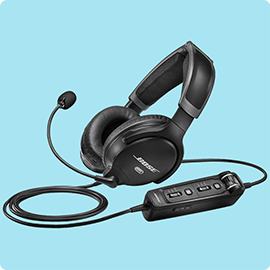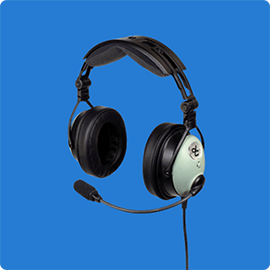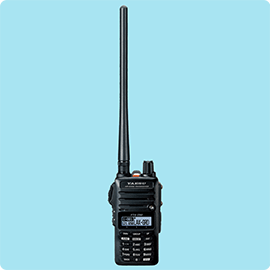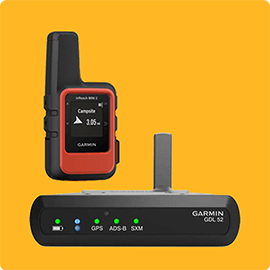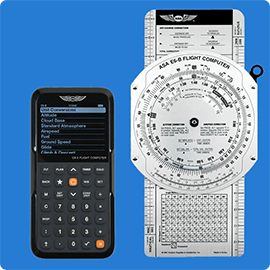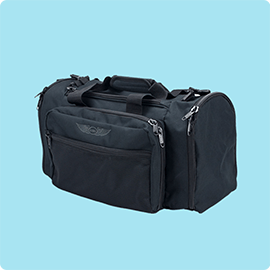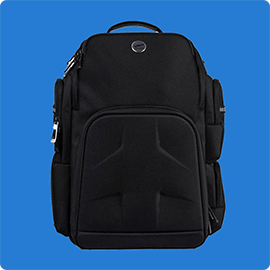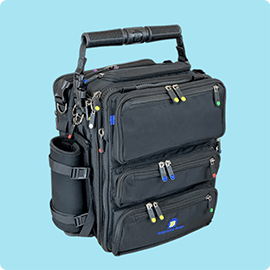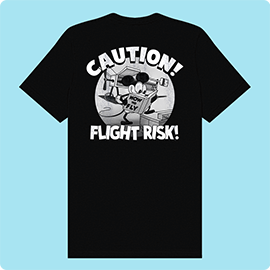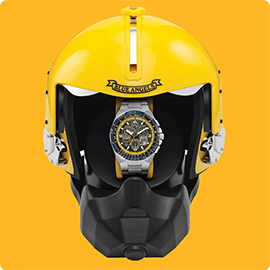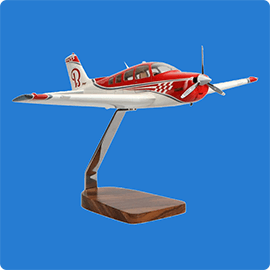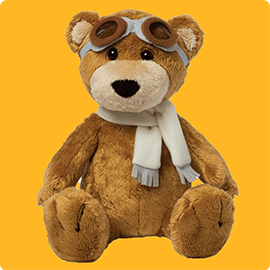How to Choose the Right Flight Bag: A Pilot's Guide to Size, Style & Features
Choosing the right flight bag is crucial for pilots of all levels, from students to airline captains. This comprehensive guide walks you through everything you need to consider, including size, style, key features like organizational compartments and durability, and how to match your bag to your specific flying needs. Whether you're a student pilot hauling textbooks, a private pilot embarking on cross-country adventures, or a professional pilot navigating airport terminals, discover the perfect flight bag to keep your gear organized and accessible. Explore popular brands like ASA, Flight Outfitters, MyGoFlight, BrightLine, Aerocoast, Travelpro, and Jeppesen to find the ideal companion for your aviation journey. Click here to read the full guide and find the flight bag that's right for you!

Selecting the perfect flight bag is almost a rite of passage for pilots. From student aviators hauling textbooks to seasoned airline captains juggling charts and crew gear, the right bag makes a world of difference. But with so many sizes, styles, and features available, how do you choose the best one for your needs? This friendly guide will walk you through everything you need to know – ensuring that no matter your flying style, there’s a perfect bag waiting for. Let’s dive in!
Table of Contents
- Key Features to Look For in a Pilot Flight Bag
- Matching Your Flight Bag to Your Flying Needs
- Comparing Popular Flight Bag Styles & Brands
- Frequently Asked Questions (FAQ)
- Conclusion & Flight Bag Recommendations
Key Features to Look For in a Pilot Flight Bag

Not all flight bags are created equal. The best pilot flight bags balance practicality with personal preference, so it’s important to consider the features that matter most to you. Here are the key factors to keep in mind when shopping for that perfect pilot bag:
Size and Capacity
Size is one of the first things to consider. Your flight bag needs to be big enough to carry all your gear, but small enough to fit in the cockpit without being a nuisance. Small training aircraft have limited space, so an enormous bag won’t do you any favors. Likewise, airline cockpits have strict size allowances for flight bags.
- What will you carry? Make a list of your essential items – headset, iPad/EFB, kneeboard, charts, logbook, flashlight, snacks, etc. Do you need room for two headsets or just one? Perhaps a laptop as well? Choose a bag that comfortably fits these items without cramming.
- Cockpit space: If you fly a two-seat trainer, a medium-sized bag might ride in the back seat during lessons. But if you start taking passengers later, that back seat might not be free! Ensure the bag can be secured up front or in a baggage area. In tight cockpits (think Cessna 152 or a fighter jet), compact is key. For airline pilots, the bag must tuck into the cockpit stowage or underfoot area per regulations.
- Expandable or modular bags: Some bags offer expansion zippers or modular add-ons to increase capacity when needed. For example, BrightLine’s modular system lets you add or remove sections to adjust the bag’s size for each. This kind of flexibility can be great if your missions vary between short hops and long hauls.
Remember, a bag that’s too large becomes bulky and hard to manage, while one that’s too small will have you leaving important items behind. Aim for “just right” – sufficient capacity with a manageable footprint in your cockpit.
Style and Carrying Method
“Style” in the context of flight bags covers both the bag type/form factor and its aesthetic or design. It also impacts how you carry the bag around. Pilots have a few popular styles to choose from, each with pros and cons:
- Shoulder Bags / Duffel-Style: The classic over-the-shoulder flight bag is a tried-and-true design. These typically have a top handle and a shoulder strap. They range from compact officer-style bags to larger duffels. Pros: Easy to access in flight (just reach to the seat next to you), generally lots of compartments, and they fit well in small spaces. Cons: Carrying a heavy load on one shoulder can get uncomfortable over long distances, and the bag may bump around if you’re walking on a windy ramp.
- Backpack-Style Bags: Pilot backpacks have become very popular, especially among students and tech-savvy pilots. They distribute weight on both shoulders and leave your hands free – great if you need to carry charts in one hand and coffee in the other! Pros: Comfortable for walking longer distances (say, across a large tarmac or airport terminal), better weight distribution, and often a sleek look. Cons: In smaller cockpits, a full backpack might be harder to stow within reach, and accessing items while in flight (on the floor or back seat) can be trickier than a side-access duffel. That said, many flight backpacks have structured designs to stand upright and zip open like a gear toolkit for easy access.
- Rolling Bags: Some pilots, especially airline and corporate crew, opt for rolling flight bags or attach their flight bag to a rolling suitcase. A rolling flight bag (essentially a small wheeled case) is ideal if you have heavier equipment or often transit through airports. Pros: No need to carry weight on your shoulder, and easy transport through terminals. Cons: Wheels and handles add weight and bulk, and a hard-case roller may not fit well in a small GA cockpit. Many airline pilots compromise by using a flight tote (a smaller rectangular bag) that slides over their rolling suitcase handle for trips. For example, Travelpro’s Crew series includes a Deluxe Crew Tote that’s perfect as a day flight bag and can piggyback on your rollaboard.
- Briefcase/Folio Bags: These are slim, professional-looking bags carried by a top handle or shoulder strap, often used by corporate pilots or those who carry minimal gear. They might have just enough space for a headset, iPad, documents, and a few small items. Pros: Very sleek and professional in appearance, lightweight, and easy to fit in any cockpit. Cons: Limited capacity – you won’t be fitting a ton of emergency gear or bulky accessories here. A good example is the Flight Outfitters Bush Pilot Folio, a vintage-style folio bag that looks great and carries the basics (headset, tablet, small accessories) in a compact form. It’s rugged and stylish but not meant for hauling every gadget you own.
- Vintage-Style Bags: Some pilots love a bit of nostalgia and opt for vintage-inspired flight bags. These could be replicas of old WWII canvas map cases or leather pilot bags. They certainly add character and often become a conversation piece at the airport. Modern versions usually include compartments for today’s gear but retain that classic look. Pros: Aesthetically pleasing and unique; often made of leather or canvas with brass fittings for that old-school vibe. Cons: Leather bags can be heavy and may require care to keep them in good shape. Also, they may lack some of the ultra-efficient pocket designs of contemporary bags.
Consider how you usually travel to the airport and move around on the ground. If you frequently navigate large airports or commute with your bag, a backpack or a bag with a trolley sleeve to attach to rolling luggage can be a lifesaver. If you fly smaller aircraft or just drive to your local airfield, a shoulder bag might be perfectly convenient. Ultimately, pick a style that matches your personal comfort and the image you want to project – whether that’s rugged bush pilot, efficient airline captain, or anything in between!
Organizational Compartments
One hallmark of a great pilot bag is its ability to keep your gear organized and accessible. In the air, you don’t want to be fumbling around in a bottomless pit of a bag to find that pen or spare battery. Look for features that cater to pilot needs:
- Multiple Pockets & Dividers: The more thoughtfully placed compartments, the better. High-quality flight bags typically feature a variety of pockets sized for common pilot gear. For instance, you might find a padded sleeve just for an iPad or EFB, dedicated pen slots, a mesh pocket for a water bottle or fuel tester, and zippered pouches for small tools. A well-organized bag means you have “a place for everything and everything in its place.” The ASA AirClassics Flight Bag Pro, for example, has padded headset pockets on each end, a side pocket for an iPad, sleeves for a kneeboard and charts, plus even a removable chart wallet – talk about organized!
- Quick-Access Sections: Think about what you might need in a hurry, either in flight or during a walkaround. External pockets are fantastic for items like flashlights, sunglasses, or a fuel tester, so you can grab them without unzipping the main compartment. Many bags include a fleece-lined pocket on top for sunglasses or a small camera, for instance. Elastic loops for pens or batteries are also common and useful.
- Padded Protection: Your headset is likely one of the most expensive items in your bag – it deserves a safe spot. Many flight bags have one or two padded headset compartments to protect those noise-canceling gem. Similarly, padded or suspended sleeves for tablets/laptops are important to prevent damage to your electronics. Check that the bag’s internal dividers have cushioning if you plan to carry fragile devices.
- Modular Organization: Some advanced bags provide configurable dividers or even removable modules. For example, BrightLine Bags use a FLEX system with interchangeable modules so you can add a section with extra pockets or remove one when you need a slimmer profile. Velcro dividers in the main compartment (as found in the ASA Flight Bag Pro) let you customize the interior layout to snugly hold your gear. This kind of flexibility can be a huge plus if your gear loadout changes from flight to flight.
- Internal Color & Visibility: One clever feature some bag makers include is a bright-colored interior lining (Flight Outfitters is known for an orange interior in some bags). Why does this matter? A high-contrast interior makes it easier to spot dark objects inside the bag, especially in a dim cockpit. It’s a small touch that improves usability – no more losing a black flashlight in a black hole. For instance, the Flight Outfitters Lift bag and duffels have that signature orange lining to help items stand out.
Before buying, envision how you’d stow all your current gear in the bag’s pockets. Do you see a logical place for each item? If you have to double-stack items in one compartment frequently, you might end up frustrated. The goal is to stay organized so that in flight, you can immediately find that charging cable or approach chart without a scavenger hunt.
Durability and Materials
A pilot’s life can be rough and tumble – and our gear goes through a lot. Between tight cockpit spaces, variable weather, and constant transport, your flight bag must withstand some abuse. Durability is key; you want a bag that lasts years, not months. Here’s what to look for:
- Tough Fabrics: Most modern flight bags use synthetic fabrics like nylon or polyester for good reason. Ballistic nylon and 600D polyester (D = denier, a measure of fiber thickness) are common choices offering excellent strength-to-weight. They resist tearing and abrasion, which is perfect for sliding in and out of cockpits routinely. Ideally, the fabric should also have a water-resistant coating (more on weather in the next section) to handle the occasional rain shower. Heavy canvas is another durable option, often used in bags aiming for a vintage or rugged aesthetic. Canvas is sturdy but can be heavier; nylon tends to be lighter and more water-resistant.
- Quality Stitching and Hardware: Check that the bag has reinforced stitching, especially at stress points like handle attachments and shoulder strap anchors. Double-stitched or even riveted seams will prevent tear-out when the bag is fully loaded. The zippers should be robust (YKK zippers are a gold standard) – a broken zipper can render a bag nearly useless. Large, easy-grip zipper pulls are a nice bonus for when you have gloves on or are in a hurry. Also examine buckles, D-rings, and clips for metal components or high-strength plastic that won’t crack.
- Reinforced Base: The bottom of the bag often takes a beating – it’s placed on wet tarmacs, dragged out of storage, and generally knocked about. Many flight bags have reinforced bases or rubber feet to handle this. For instance, the ASA Flight Bag Pro has sturdy plastic feet to keep the bag elevated and clean, as well as wrap-around reinforcing straps for longevity. A reinforced or padded base also helps protect contents if you set the bag down hard.
- Built to Last Design: Some brands pride themselves on “mil-spec” durability. Look for phrases like “able to stand up to the toughest treatment”. It’s not just marketing fluff if backed up by materials and warranty. For example, MyGoFlight’s PLC Pro is made of ballistic nylon – a material originally developed for military flak jackets – indicating it’s built for frequent travel and heavy use. Travelpro, a brand virtually synonymous with airline crew luggage, has a reputation for bags that survive years of constant flying; their crew totes and rollaboards are favorites among airline pilots because of this durability.
- Weight vs. Durability Trade-off: A super-rugged bag might use heavier materials, which can increase the bag’s empty weight. If you’re concerned about every pound, you might opt for a lighter bag that is adequately durable rather than over-built. But generally, pilot bags are designed to be lightweight yet tough. Durable fabrics like nylon and canvas are lightweight and easy to clean – ideal for aviation use. So you usually don’t have to sacrifice too much. Just be cautious of very cheap, no-name bags which might skimp on material quality; they may fray, tear or have straps fail after just a short period of use.
In short, invest in a bag that can handle the demands of your flying routine. A well-constructed flight bag not only protects your pricey equipment but also saves you from the annoyance (and expense) of replacing a worn-out bag frequently. As the saying goes, “buy it nice or buy it twice.” In the case of flight bags, this definitely rings true.
Weather Resistance
Pilots are no strangers to the elements – one minute you’re under clear skies, the next you’re sprinting through a downpour on the ramp. That’s why weather resistance is an important feature for any flight bag. After all, the bag often guards critical documents and electronics that you really don’t want getting soaked.
- Water-Resistant Materials: Most quality flight bags come with at least a water-resistant outer fabric. For example, many use nylon or polyester with a polyurethane or PVC coating on the inside to prevent water ingress. A bag like the Jeppesen Student Pilot Bag is made from 600D polyester and even has a PVC coating for extra water resistance – helpful for those training flights when you get caught in the rain unexpectedly. “Water-resistant” isn’t the same as fully waterproof (you can’t submerge the bag without leaks), but it will handle light rain and splashes just fine.
- Covered Zippers and Flaps: Pay attention to how the compartments seal. Zippers can be a weak point for water to seep in. Some flight bags use covered zippers (with fabric flaps over them) or even waterproof zipper designs to keep rain out. If you expect to be in heavy rain frequently (say, flying in the Pacific Northwest or tropical regions), this becomes more important.
- Rain Covers: A few bags might include a separate rain cover – a waterproof slip or hood that goes over the bag in bad weather. This is more common with hiking backpacks, but a handful of pilot bags or modular systems might offer it as an accessory. If not, you can always stow a large plastic trash bag inside your flight bag and use it as an impromptu rain cover in a pinch! (Pro tip from many an airport ramp worker – garbage bags are multi-use marvels.)
- Temperature and Sun Exposure: Weather resistance isn’t just about rain. Consider UV exposure if you use a canvas or leather bag – prolonged sun can fade and weaken some materials. Nylon is quite UV-resistant and a safe bet if you leave your bag sitting in the sun on the ramp often. Also, extreme cold can make plastics (like cheap buckles or wheels) brittle, whereas metal hardware endures better. These are minor points unless you operate in extreme climates, but worth noting.
- Protection from the Environment: If you’re into seaplane flying or island hopping, think about saltwater and humidity. Saltwater can be harsh on zippers and metal parts – you’d want corrosion-resistant hardware. Likewise, a fully waterproof dry-bag style might be worth it if there’s a chance your bag could take a dunk (perhaps less common, but imagine a floatplane docking scenario). For most pilots, water-resistant fabric is enough, but more adventurous flying may call for a more rugged waterproof gear case or at least packing sensitive items in Zip-lock bags inside.
Most of the time, ensuring your bag is made of water-repellent material and has good closures is sufficient. You want to be confident that if a sudden rain shower pops up, your logbook, charts, and electronics won’t emerge looking like papier-mâché. Many popular bags explicitly advertise their weather-resistant features – for instance, Aerocoast crew bags use durable, water-resistant fabrics to protect contents during the daily grind. Choose a bag that can brave the elements as well as you do.
Comfort and Ergonomics
While a flight bag spends a lot of time sitting in the airplane, it also spends time on your shoulder or back as you trek to and from that airplane. Comfort might not be the first thing you think of, but it can make a big difference – especially if you frequently travel with your bag.
- Shoulder Straps: If the bag has a shoulder strap, it should be well-padded and preferably non-slip. A pad helps distribute the weight so the strap doesn’t dig into your shoulder. A non-slip grip (rubberized or textured) keeps it from constantly sliding off. Many flight bags include a detachable shoulder strap, which is great for flexibility – you can remove it when stowing the bag in a tight cockpit to avoid snagging on things, then clip it back on to carry out. Look for wide straps; a skinny strap with 40 pounds of gear will hurt!
- Handles: Nearly all bags have basic carrying handles. The best have a soft cover (leather wrap or padded Velcro wrap) that joins twin handles into one and gives a comfortable grip. This “comfort grip” makes it easier to grab the bag with one hand when needed. If you opt for a backpack style, make sure the top grab handle is robust and comfortable as well – you’ll use it often to lift the bag in and out of tight spaces.
- Backpack Ergonomics: For pilot backpacks, the back panel and shoulder straps are crucial. Look for breathable padding on the back (you don’t want a sweaty back every time you carry it across the apron) and adjustable, contoured shoulder straps. Some even have a sternum strap or waist strap for extra support, though that might be overkill for a flight bag unless you truly load it heavy. One cool feature on some bags (like certain BrightLine configurations) is the ability to add backpack straps to a bag that can also function as a shoulder bag. This convertible approach gives you options for comfort.
- Balanced Design: A bag that’s well-designed will sit upright on its own and won’t tip over easily when filled. A self-standing bag with a flat, weighted base is nice because you can set it down anywhere and not worry about it face-planting (potentially spilling your carefully organized contents). This also plays into comfort – you’re not constantly bending over or fighting a floppy bag. High-quality padding in the structure of the bag can help it keep shape and protect your gear.
- Carrying Method Match: Consider your routine: do you often have long walks with your flight bag? (Think student pilots walking across campus-style airports, or airline pilots from parking lot to crew room.) If yes, prioritize comfort features like backpack capability or a rolling option. If you only ever carry it from the car to the hangar, comfort is still important but you might not need every bell and whistle.
- Attachment Points: Ergonomics can also mean convenience attachments. Many crew flight bags have a trolley strap – a sleeve on the back that lets you slide the bag over the handle of a rolling suitcase. This is huge for airline and corporate pilots who travel with overnight luggage; it means one less thing on your shoulder. For example, Flight Outfitters’ Crew Duffel has a strap to secure it on top of rolling luggage, combining the capacity of a duffel with the convenience of wheel transport.
In summary, don’t underestimate comfort. A bag might have all the pockets you need but if it’s awkward or painful to carry, you’ll soon dread using it. The best flight bag is one that “disappears” when you carry it – you can focus on your flying, not the strain on your shoulder. Pilots often carry these bags through parking lots, FBOs, terminals, up aircraft stairs, and more. So, look for ergonomic touches that make carrying your gear as effortless as possible. Your body will thank you after those long cross-country days or multi-leg airline trips.
Matching Your Flight Bag to Your Flying Needs
Now that we’ve covered features, let’s talk about how different types of pilots and flying adventures call for different things from a flight bag. A student pilot doing traffic patterns all day has different needs than a bush pilot landing on riverbeds, or an airline captain crisscrossing the country. Here, we break down considerations by pilot type and flying mission:
Student Pilots & Training Flights
Challenges: Student pilots are usually learning in smaller aircraft, often carrying a lot of training materials. Think textbooks, checklists, syllabus printouts, FAR/AIM manual, plotter, E6B flight computer, and more – on top of the standard gear like headset and logbook. Organization and capacity are key. Students also frequently have an instructor by their side, and may use the back seat for storage on training flights (if you’re in a Cessna 172, for example, your flight bag might ride in row 2).
What to look for: As a student, you might actually need a larger bag than you will once you’re a licensed pilot. During training, it’s common to err on the side of bringing everything (just in case). Choose a bag with ample space and lots of compartments to keep study materials separate from your kneeboard and headsets. A dedicated section for books or an expandable file pocket for charts and flight plans is useful. Padded protection for your headset is a must – you want to protect that investment from day one.
Other considerations: Affordability is often important for students (flight training is expensive enough!). Luckily, there are great budget-friendly flight bags designed for students. The Jeppesen Student Pilot Bag is a perfect example: it’s compact yet has 7 exterior pockets for organizing all your small tools and notes, and it’s built from durable 600D polyester with a water-resistant coating to handle the rigors of training – all at a very reasonable price. Another good choice might be the ASA Pilot Bag or similar entry-level bags around the ~$50 range. They won’t have fancy leather trim or modular expansions, but they are practical and sturdy enough for the training years.
Student Pilot Tip: You’ll likely refine what you carry as you progress. Many student pilots initially overpack, then realize after a few lessons which items never leave the bag. Use those pockets to your advantage – keep the frequently used items (like pens, fuel tester, checklist) in outer pockets, and seldom-used reference materials in a less accessible spot. As you pass milestones (first solo, cross-country, etc.), you might slim down your kit. Some students even “downsize” their bag upon moving to advanced training when less rote reference is needed. But to start, don’t be afraid to get a slightly larger bag to accommodate the learning curve.
Private Pilots & Cross-Country Adventures
Profile: You’ve got your license – congrats! Now you might be flying for $100 hamburgers, weekend cross-country trips, the occasional family outing, or just staying proficient with local flights. Private pilots have more freedom to choose what they carry, and often flights can be a mix of short local hops or longer cross-countries. The key here is versatility.
What to consider: Your flight bag now might carry a bit less in terms of books (since you’re not hauling the training manual everywhere), but you may have additional gear like an iPad (with an EFB app), perhaps a portable ADS-B receiver, a handheld radio for backup, personal items, and maybe even an overnight kit if you do a weekend trip. A medium-sized bag that balances capacity with portability is ideal.
If you plan lots of cross-country flights, think about extras you might need: backup batteries, a SPOT or PLB, snacks and water, perhaps a small first-aid or survival kit depending on terrain. It’s wise to have a bag that can accommodate these items in addition to the basics. This is where something like the Flight Outfitters Lift 2.0 or ASA AirClassics Gen 3 bag shines – they’re not huge, but they have enough room and compartments to hold a wide array of gear and keep it orderly. The Flight Outfitters Lift, for example, is a compact bag with a large padded headset pouch, multiple exterior pockets, and even reinforced sides for durability. It’s great for those “short flights around the practice area” or day trips.
For longer journeys, you might prefer a slightly bigger bag or one that can pair with luggage. If you do the occasional overnight trip, consider a bag with a trolley sleeve (to slide onto a suitcase) or maybe use a crew duffel as your flight bag which doubles for clothes. Flight Outfitters has a Crew Duffel with a pass-through for luggage handles – that could be overkill for just a day trip, but wonderful if you combine gear and personal items in one bag.
Type of flying: If your private flying involves IFR (instrument flying) or technical flights, you may have more charts or approach plates (though likely on a tablet these days). Ensure your bag has space for an IFR binder or that your EFB setup is well-protected. If you’re VFR-only, your gear might be lighter, focusing on situational comforts (like sunglasses, camera, snacks) along with required equipment.
For the efficient GA pilot: Once out of training, many pilots refine their kit to just what they need. This is a good time to consider if you want to continue with a shoulder bag or maybe switch to a backpack style if that suits you. Backpacks like the Flight Outfitters Aviator Backpack offer the capacity of a mid-sized bag with the comfort of backpack carry, plus they often include a laptop compartment and lots of organization. These can be great if you’re a private pilot who is also a tech professional on the weekdays – you can use the same bag for flying on the weekend and commuting to work with your laptop during the week!
Seaplane Hopping & Island Flying
Profile: Do you find yourself landing on water or taking short hops between tropical islands? Lucky you! Pilots who fly seaplanes, floatplanes, or island commuter hops have a few unique considerations. Often these flights are VFR fun in beautiful locales, but the environment can be harsh – water, salt, sand, and sun.
Key needs: Weather resistance jumps to the top of the list here. You want a bag that laughs off water spray. A quick-drying, synthetic material (nylon/poly) is almost mandatory; leather is probably not ideal around saltwater and humidity. Look for corrosion-resistant zippers (plastic zippers won’t corrode, and high-quality metal ones should be treated). It might be wise to actually stash any truly water-sensitive items (like paperwork or electronics) in waterproof pouches within your bag if you’re regularly around water.
Size & type: Seaplane cockpits (like a DHC-2 Beaver or Cessna Caravan on floats) can vary in space. Many seaplane pilots prefer a backpack or a soft duffel that can be squished a bit, since hard cases don’t play nicely in smaller floatplane cabins or boats. A backpack leaves your hands free as you climb onto a dock or wade ashore. Also, if you accidentally set your bag in a bit of water (those slippery docks!), a water-resistant base or feet will protect your gear.
Special features: For island hopping pilots, sometimes the flight bag doubles as a general travel bag. You might carry swim gear, a change of clothes, or picnic supplies along with your aviation gear. A slightly larger multi-purpose bag or a modular bag you can expand is useful here. Perhaps a BrightLine Bags system could be handy – you could add a module for extra storage when needed and remove it for lean operations. Another niche feature: If your flights involve crossing international waters (like Bahamas trips), ensure your bag has a secure place for documents (passport, airworthiness certificate, etc.) so they stay dry and safe.
Example: An Aerocoast Cooler bag might ironically be a


